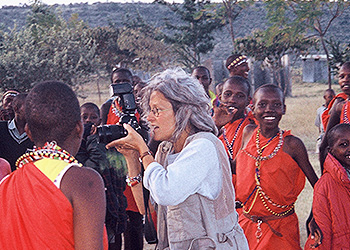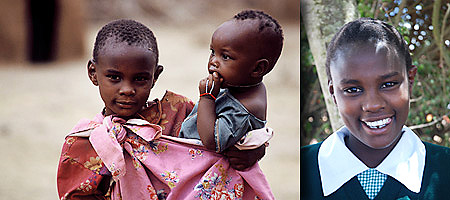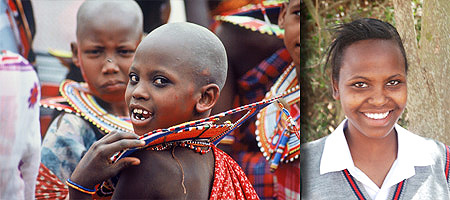In August 1999, the founder of the Fund, Barbara Lee Shaw, began a photography project to document the Maasai culture. At the invitation of Meitamei Ole Dapash, the International Coordinator of the Maasai Environmental Resource Coalition, she spent a week camping near a Maasai village in Kilonito, an area about 90 kilometers south of Nairobi. During their week in Kilonito, they visited several Maasai villages, enjoying their hospitality, dances, and humor. It was in Kilonito that they discovered the irresistible charm of two Maasai girls named Ntanin Tarayia and Sempeyo Sarinke – the girls who inspired the creation of the Maasai Girls Education Fund.
 Barbara explains:
Barbara explains:
During my week in Kilonito, I was able to observe closely the daily routines of the Maasai people. I sat on the ground with Maasai women neating their beads, and walked with Maasai boys as they guided their cattle and goats to the dry “river” to drink water pumped from an aquifer. I witnessed the hard life of Maasai women, whose days were spent caring for their many children, walking several kilometers to get water, washing clothes at the aquifers, gathering wood, and milking goats and cows. Maasai women taught me to cook chapati over an open fire. They also taught me the movements of their graceful dances. The experience gave me great respect for the Maasai, who have minimal physical comforts, but have immeasurable wealth in their cultural dignity, something that impoverished societies without their culture intact have been denied.
I met Ntanin on my first day in Kilonito, as she lived in a house beside the entrance to her village. She approached me shyly with her head bowed, as is the custom between Maasai children and adults, inviting me to touch the top of her head, which I did. She then quickly retreated, with a big smile. I loved her spirit, her curiosity, and her courage. After that first encounter, I looked for her every time I returned to the village. Each day she wore the same dress, a flowered print on a faded pink background, obscured by layers of dust that seemed permanently integrated into the fabric, and she was always carrying a younger sibling straddled across her hip. Each day more and more little girls ventured to greet us when we arrived, but these girls were dressed in traditional Maasai style with multi-layered, brightly colored “sheets” and elaborate, beaded necklaces. Ntanin wore the same dusty dress until the last day, when she too was dressed in Maasai fashion. I knew I could never forget that little girl.

Ntanin Tarayia in 1999 and now.
As I spent my days walking from village to village, I learned about the problems of the Maasai people–poverty, inadequate health care, and illiteracy, especially among the women. Kenya’s education system was explained in detail. I visited the Kilonito Primary School, which serves a community within a 15-mile radius. There, I began to understand the need for more boarding schools, which would allow children who live too far from the local day schools to have a chance for an education.
Through my experience that week, I learned about the almost inevitable fate of Maasai girls to never learn to read, write, or speak a language other than their own native Maa; to be circumcised at the age of twelve or thirteen and married to a man her father chooses; to have many children regardless of her ability to provide for them; and to be dependent her whole life on a man and a family she did not choose.

Sempeyo Sarinke in 1999 and now.
I hated to think of such a fate for Ntanin. But she is the sixth child of her father’s third wife, and would never have a chance to attend school. On my last day in Kilonito, I inquired about how I might support the education of Ntanin. A friend who was traveling with me also wanted to support the education of a little girl who had touched her heart — Sempeyo. Sempeyo is the seventh child of her father’s first wife, and also was to be denied the opportunity for education. Arrangements were made with the families and schools to make it all possible. Both Ntanin and Sempeyo are the first girl in their families to enroll in school.
During the next year, others learned about Ntanin and Sempeyo and wanted to sponsor the education of Maasai girls too. Their interest and the conviction that increasing literacy among Maasai women in Kenya would have far-reaching benefits to all Maasai, combined to bring about what now seems like the inevitable formation of the Maasai Girls Education Fund a year later. Soon there were six girls sponsored by the Fund. Within one year, there were 12, then 16, then 36, and, by 2005, more than 50. As of December 2021, MGEF has provided scholarships to 254 Maasai girls.
